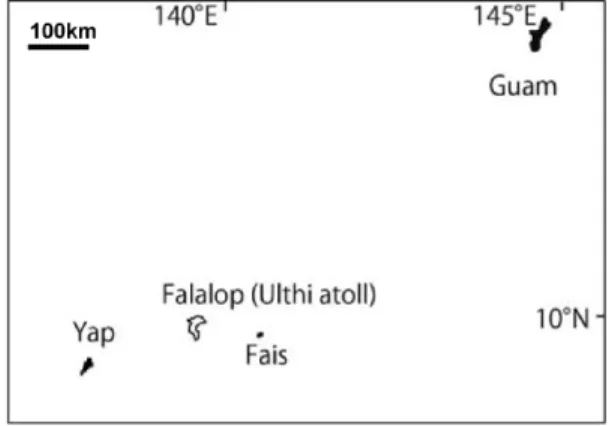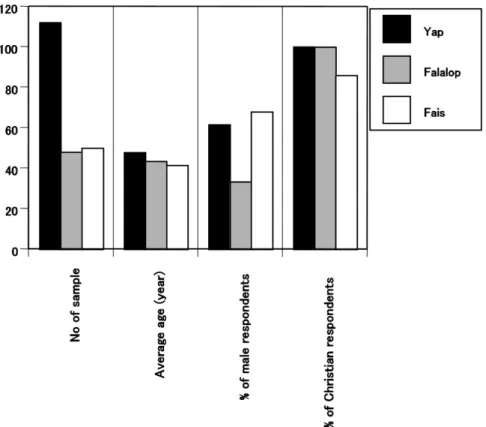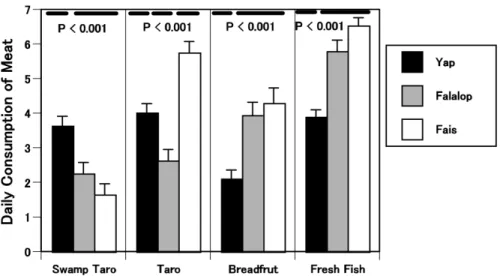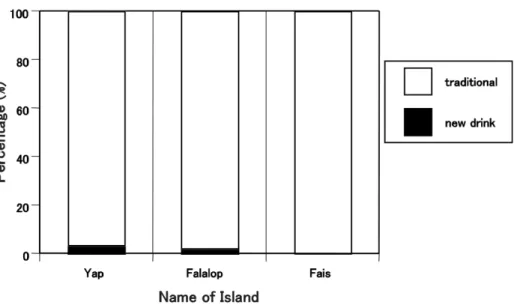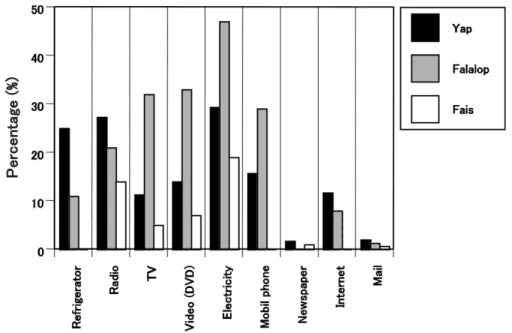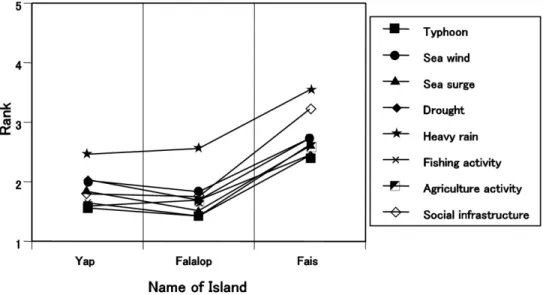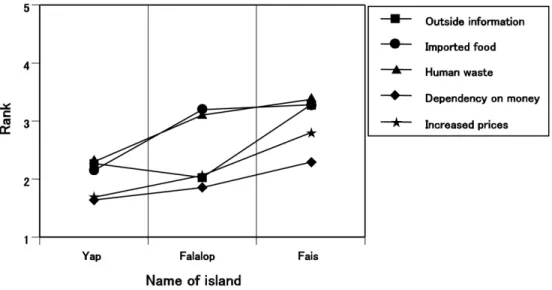Micronesian Region : Case Study of Islands in
Yap State, Federated States of Micronesia
著者
KAWAI Kei, KUWAHARA Sueo, TERADA Ryuta,
TOMINAGA Shigeto, NODA Shinichi, NAGASHIMA
Shunsuke
journal or
publication title
南太平洋研究=South Pacific Study
volume
31
number
2
page range
57-70
South Pacific Studies Vol.31, No.2, 2011
Influence of Environmental Changes
on the Micronesian Region:
Case Study of Islands in Yap State,
Federated States of Micronesia
KAWAI Kei 1, KUWAHARA Sueo 2*, TERADA Ryuta 3, TOMINAGA Shigeto 4, NODA Shinichi 1, NAGASHIMA Shunsuke 1
1: Research Center for the Pacific Islands, Kagoshima University, 2: Faculty of Law, Economics and Humanities, Kagoshima University,
3: Faculty of Fisheries, Kagoshima University,
4: Faculty of Agriculture, Kagoshima University *Corresponding author: kuwahara@leh .kagoshima-u.ac jp
Abstract
To study the influence of globalisation and global warming on the islands in Yap State with reference to data developed from a questionnaire on food, lifestyle and local awareness of globalisation and global warming and their effects on human and natural environments, research was conducted in Yap proper (Gilman, Gachpar and Wanyan villages) and the Falalop and Fais Islands in November 2008. On the basis of the results of the survey, this study attempts to verify a 'centre-periphery' hypothesis that focuses on the accessibility between each island and Guam, the developed core (or centre) of the Micronesian region. Some results support the hypothesis; however, different trends were also observed in the three islands. The average daily consumption of rice (modern food) in Falalop was higher than that in Yap, which is the closest to an urban area, and in Fais, which is a distant remote island. However, people in Yap and Fais consumed taro (traditional food) more frequently than rice (modern food). On the other hand, people in Falalop consumed frozen meat more frequently than fresh meat. The percentage of households possessing electricity was higher in Falalop than that in the other islands. This might be the reason that people in Falalop consumed frozen meat more frequently than fresh meat. The percentage of people who consumed traditional beverages (coconut juice and fresh water [not store-bought]) was much higher than that who consumed new beverages (mineral water and other beverages) in all the three islands. Awareness of the effects of climate change was higher in Yap and Falalop than in Fais. The physical effect of a typhoon and aid to support victims may have affected social systems and led to economic disparity. Finally, we discuss other factors related to environmental changes that affect the social system.
Key Words: centre-periphery hypothesis, globalisation, global warming, integrated disciplinary, questionnaire
Received: 22 December, 2010 Accepted: 14 February, 2011
Introduction
Various environmental changes, such as globalisation and global warming, are affecting people's lives in many significant ways. Because of their small size and fragile ecology, islands are particularly affected by such large changes. For example, global warming causes seas to rise. Coral reef bleaching too is attributable to warmer sea temperatures. El Nino and other climate variability have been observed in recent decades (DREXLER and EWEL 2001, GATES et al. 1994). Meanwhile, it has been reported that the transition from eating traditional foods to processed foods due to globalisation causes people to be obese (CASSELS 2006, EVANS et al. 2001, HUGHES and LAWRENCE 2005).
The understanding of globalisation varies among scholars; however, it is generally understood as the establishment of simultaneity and standardisation in communication by the spread of computer, the phenomenon of rapid progression of American standardisation of the world by transnational companies, and also the American way of standardisation in politics, military affairs, economics and culture (NAKASHIMA 2005). It can also be understood as a matter of `centre-periphery', i.e. the relationship between Euro-American (advanced countries or urban centres) and other countries (developing countries or non-urban centres).
In addition, it is possible to understand globalisation as the dissolution of the boundary in political, economic and cultural activities or as a fluctuation of a system called the nation-state in modern days (IYOTANI 2002). Furthermore, because globalisation is understood as a phenomenon which has existed since long before the 20th century (e.g. HELD 2000), people's lives and cultures, which had long been under capitalism, have been exposed by a stream of globalisation. Also, as a viewpoint to understand globalisation, `process'
, `condition' and `political project' are believed to be important. Therefore, gaining an understanding of the influence of globalisation on each area and of the process of change within a politically same country is necessary for improving life in those areas.
Our theoretical stance on the `centre and periphery' matter is not the same as the subordination theory of AMIN (1983) and FRANK (1980) or Wallerstain's World System theory (WALLERSTEIN 1981), but lies more within the context of globalisation. That is, our purpose is to discuss the influence of globalisation in the islands of Yap State in relation with the distance from the centre (Guam in our context). However, the `distance' does not necessarily mean geographic distance but rather accessibility to the centre, which includes
traffic, information-communication and the movement of people and goods.
KAWAI et al. (2010) and NAGASHIMA (2010) conducted a case study on people whose lives were affected by various environmental changes in three islands in Pohnpei State, the Federated States of Micronesia (FSM). KAWAI et al. (2010) examined the changes according to the `centre-periphery' hypothesis, which considers the distance (accessibility) between each of the three islands and Guam, the urban centre of the Micronesian region. Their results show that meaningful `centre-periphery' differences exist among the three islands with regard to inhabitants' principal diet. A significant correlation can be seen
KAWAI et al: Influence of Environmental Changes on the Micronesian Region 59 between those islands closer to the centre and the consumption of processed foods. In short,
closer an island is to the centre, more processed foods its residents consume.
Due to the complexity of social and natural environments, it is important to study these changes from two viewpoints. First, it is imperative to increase the number of case studies to investigate the changes in different areas according to the same hypotheses. For example, because FSM has four states that are located on the same latitude, it is easy to compare influences on the basis of minimum assumption: for example, we ignore the effect of different national governance systems and different latitudinal effects (mainly temperature). Therefore, FSM is a good research area because we can perform four case studies on the basis of the minimal variables. Second, to study complex systems, such as society and nature, it is important to understand them from the viewpoint of many different academic fields. To implement this research, we adopt the integrated disciplinary method (KAWAI 2009), which differs from the ordinary anthropological approach. The important techniques in this method are as follows: 1) various academic researchers join the project, 2) all researchers stay in the same research area at the same time to conduct the same experiments and to share the same knowledge and 3) statistical analysis is adopted to combine various academic ideas. In this study, anthropologists, marine biologists, botanists, economists and public health doctors conducted research using a questionnaire and revealed the effect of
environmental changes on three small islands in Yap State, FSM.
Materials and Methods
The research was conducted in Yap proper (Gilman, Gachpar and Wanyan villages) and the islands of Falalop and Fais in November 2008 (Fig. 1). To compare the data from Yap, Falalop and Fais, the values for Yap were taken as the average value of the three villages surveyed. We adopted a questionnaire survey that was administered by a native speaker, which was the same method employed in Pohnpei in 2007 (KAWAI et al. 2010).
Fig. 1. Map showing the research area: the islands of Yap, Falalop and Fais, Federated States of Micronesia.
The detailed method and hypothesis are explained in KAWAl et al. (2010). To compare the data among the three islands, we performed one-way ANOVA and multiple comparison test with the Bonferroni correction by SPSS.
Table 1 shows statistical data on population and transportation in the three research areas. Geologically, Fais is closer to Guam (urban centre) than Yap proper. However, because Colonia in Yap proper is the capital of Yap State, which administers Yap proper and other atolls and Yap proper is commercially important in Yap state, larger planes operated between Guam and Yap at least four times per week, and smaller airplanes go into commission between Yap, Ulithi (Falalop) and Fais twice per week. Therefore, Yap proper has more accessibility with Guam and might be the most urbanized place of the three research areas. The population of Yap proper is 10 times higher than that of Ulithi Atoll, which includes Falalop. Percentage of marital status for population aged 15years and over is 67%, 61% and 51% in Yap proper, Ulithi Atoll and Fais, respectively, which indicates that the outer islands have lower percentages.
Table. 1. Statistical data of three research sites, Yap proper, Falalap (or Ulthi Atoll), and Fais.
Yap Falalop (Uliti Atoll)
Fais Reference
Population (2000)
Marital status for population aged 15years and over (2000) Distance from Guam (km) Frequency of flight (n / week) Number of seat of airplane
7391 4862 844 4 124 773 (Uliti) 473 (Uliti) 662 2 (Uliti) 9 (Uliti) 215 109 618 2 9
YAP BRANCH STATISTICS OFFICE (2007) YAP BRANCH STATISTICS OFFICE (2007)
Results Basic data on the sample
The household sample number for Yap proper was higher than that for the other islands because Yap proper includes the three villages (Fig. 2). The sex ratio in Yap and Fais indicates that the population is over 60% male, and in Falalop it is 60% female. In each
island, over 90% of the population is Christian. Modern and traditional food
Figure 3 shows the average daily consumption of traditional food (swamp taro, taro, breadfruit and fresh fish) in the islands of Yap, Falalop and Fais. The average daily consumption of swamp taro in Yap, which is closest to Guam, was significantly lower than that in Falalop and Fais (one-way ANOVA P < 0.001). The daily consumption of taro in Fais was significantly higher than that in Falalop and Yap, and significantly lower in Falalop than that in Yap (one-way ANOVA P < 0.001). The average daily consumption of breadfruit and fresh fish in Yap, which is closest to Guam, was significantly lower than that
KAWAI et al: Influence of Environmental Changes on the Micronesian Region 61
Figure 4 indicates that the respondents in the three islands consumed modern food, identified as rice, instant noodles (ramen), bread, canned meat and canned fish, several times a week. The average daily consumption of ramen, bread and canned meat in Yap, which is closest to Guam, was significantly higher than that in the islands of Falalop and Fais (one way ANOVA, P < 0.001). This appears to confirm that the islands closer to an urban centre (Guam) are becoming more globalised. However, the frequency of rice consumption in Yap and Fais was significantly lower than that in Falalop (one-way ANOVA, P < 0.001).
Figure 5 shows how many times in one week people in the three islands consumed meat (frozen fish, beef, pork and chicken). The frequencies of rice consumption with frozen fish, beef and pork showed the trend similar to that in the other modern commodities. The frequencies of consumption of frozen fish, beef and pork in Yap and Fais were significantly lower than those in Falalop (one-way ANOVA, P < 0.001). The average daily consumption of chicken in Fais was significantly lower than that in Falalop and Yap (one-way ANOVA, P < 0.001).
Figure 6 shows the percentage of people in each island who consumed traditional, as
Yap
Falalop
Fais
Fig. 2. Basic data from the household questionnaire used in the islands of Yap, Falalop and Fais: sample number, average age, percentage of male respondents and percentage of
dents who identified themselves as Christians in the questionnaire.
Yap
Falalop
Fais
Swamp Taro Taro Breadfrut Fresh Fish
Fig. 3. Average daily consumption of traditional food (swamp taro, taro, breadfruit and fresh fish) in the islands of Yap, Falalop and Fais. Vertical bars at the top of the columns show
the standard sample error. Value for Yap Island is the average value of Gilman, Gachpar
and Wanyan villages.
Yap
Falalop
Fais
Fig. 4. Average daily consumption of modern food (rice, ramen, bread, canned meat and canned fish) in the islands of Yap, Falalop and Fais. Vertical bars at the top of the column bars
show the standard error. Value for Yap Island is the average value of Gilman, Gachpar
and Wanyan villages.
KAWAI et al: Influence of Environmental Changes on the Micronesian Region 63
Yap
Falalop
Fais
Frozen Fish Beef Pork Chicken
Fig. 5. Average daily consumption of meat (frozen fish, beef, pork and chicken) in the islands of Yap, Falalop and Fais. Vertical bars show the standard error. Value for Yap Island is
the average value of Gilman, Gachpar and Wanyan villages.
traditional
new drink
Yap Falalop Fais
Name of Island
Fig. 6. Percentage of people in each island who consume either traditional or new drinks. Traditional drinks include water and coconut juice. New drinks include store-bought
beverages and mineral water. Value for Yap Island is the average value of Gilman, Gachpar and Wanyan villages.
opposed to modern drinks. The percentage of new or modern beverages being consumed in Yap was high, although people in all the three islands considerably prefer traditional drinks. Again, this appears to affirm the `centre-periphery' hypothesis that islands closer to an urban centre are more globalised in their dietary patterns.
Electrical equipment and communication
Household possession of electrical equipment (refrigerators, radios and the Internet) registered high in Yap (Fig. 7). Other electrical appliances (TV, DVDs, mobile phones and electricity supply) and newspapers were more commonly owned in Falalop than in Fais and Yap. Because the diffusion rate of the landline phone is low in developing countries, once a mobile phone has entered the community, the diffusion rate rapidly increases. Moreover, Yap (closest, richer and most developed area) was able to benefit from the earlier technological advance, thus there is less need for mobile phones. This is why their diffusion rate is high in Falalop but not in Yap.
Figure 8 shows the average values in the awareness of increased typhoons, sea winds, sea surges, droughts and heavy rains, and the effects of these climate changes on fishing and agricultural activities and social infrastructure. All the average values in Yap and Falalop showed a similar trend, which indicated an awareness of increased typhoons, sea winds, sea surges, droughts and heavy rains, indicating that people were very concerned about these
Yap
Falalop
Fais
Fig. 7. Percentage of households possessing electronic equipment (refrigerator, radio or TV and DVD player) in the islands of Yap, Falalop and Fais. Right bar shows the number of
items of mail received per month in each island. Value for Yap Island is the average
value of Gilman, Gachpar and Wanyan villages.
KAWAI et al: Influence of Environmental Changes on the Micronesian Region 65 Typhoon Sea wind Sea surge Drought Heavy rain Fishing activity Agriculture activity Social infrastructure Name of Island
Fig. 8. Average values for the awareness of increased typhoons, sea winds, sea surges, droughts and heavy rains and those of the effects of these climate changes on fishing and
tural activities and social infrastructure. 1: Extremely concerned; 2: considerably
concerned; 3: concerned; 4: not considerably concerned; 5: not concerned at all. Value for Yap Island is the average value of Gilman, Gachpar and Wanyan villages.
Loss of traditional customs
Weakening of community consciouness Depopulation
Social order disturbance
Yap Falalop Fais
Name of island
Fig. 9. Average values for the concern for loss of traditional customs, weakening of community awareness and disturbances to the social order related to globalisation. 1: Extremely
concerned; 2: considerably concerned; 3: concerned; 4: not considerably concerned; 5:
not concerned at all Value for Yap Island is the average value of Gilman, Gachpar and
Wanyan villages.
issues. However, people in Fais were not significantly concerned about these matters.
Figure 9 shows concern for the loss of traditional customs, weakening of community awareness and disturbances to the social order related to globalisation. People in Yap, which is near the core area, have high awareness of community; however, people in Fais, which is a distant remote island, have low awareness. In particular, the weakening of
community awareness and disturbances to the social order that are related to globalisation was observed to a small extent which means that people were considerably concerned. After
Yap suffered from Typhoon Sudal in 2004, it received a large amount of American aid, which influenced the social system and created economic disparity among the people.
Consequently, people there were concerned about social changes, as seen in Figs. 8 and 9. Our survey revealed that community awareness of all these issues showed a similar trend to that evident in consumption practices. Figure 10 shows that people in Yap, which is near a modern area, have high awareness of social stress; however, people in Fais, which is a distant remote island, have weak awareness. Awareness in Fais showed high awareness, which means that people are not considerably concerned, because electronic devices and
electricity are not common; therefore, the community might have less information and the social system might be sustainable, but not the monetary economic community.
Outside information Imported food Human waste Dependency on money Increased prices Name of island
Fig. 10. Average values for the awareness of the effects of outside information, imported food, imported goods, human waste disposal, dependency on money and increased prices on
the local island community. 1: Extremely concerned; 2: considerably concerned; 3:
concerned; 4: not considerably concerned; 5: not concerned at all. Value in Yap Island
is the average value of Gilman, Gachpar and Wanyan villages.
KAWAI et al: Influence of Environmental Changes on the Micronesian Region 67
Discussion
We studied the effect of environmental changes on the three small islands in Yap State and verified the `centre-periphery' hypothesis, which considers the accessibility between each of the three islands and Guam, the urban centre of the Micronesian region. Accessibility is an important factor in this hypothesis. The `centre-periphery' hypothesis can explain some observed data, but not all, such as data on rice, some meats and taro (Figs. 2-7). We also found some data that could not be explained by the `centre-periphery' hypothesis in Pohnpei, FSM (KAWAI et al. 2010). This suggests that other factors are also
important for explaining the data from different viewpoints, including those of natural science, society and history.
The size of an island, distance between an island and continent and migration are important factors in the equilibrium theory of insular zoogeography (MACARTHUR and WILSON 1967). The size of an island affects its population and in turn, the population size considerably relates to the amount of information available to the island as well as its infrastructure and monetary economy, which affect the social system. In addition, human migration induces globalisation. Historically, human migration was likely to occur in the east-west direction because air temperature is similar in the same latitude and humans can easily adapt to a new place if the air temperature is similar (DIAMOND 2000). Wind direction and current are important factors in migration in the Oceanic area. In a network among Yap, Falalop (Ulithi Atoll) and Fais, called the Sawei network, people moved in the west-east direction (LESSA 1950). However, transportation and an administrative district are currently more important factors in migration than natural ones, such as wind direction and current. Our research was conducted in three islands in one state of FSM; therefore, the administrative district may not considerably disturb migration among these islands. Large aircrafts are in commission between Yap and Guam, whereas small ones are used among Yap, Falalop and Fais. Therefore, number of seats, frequency of flights and airfare are also important factors in migration, and these may induce globalisation and affect the social system. Vessels are another type of transportation. The frequency of shipping is low in FSM; however, vessels can take large freight, such as refrigerators. Therefore, freight
capacity is also an important factor.
Yap, Falalop and Fais are a volcanic island, an atoll and an uplifted coral reef island, respectively. Generally, there are taller mountain(s) in volcanic islands, but an atoll is a low island. Thus, these islands have different landscapes (YAMAGUCHI 2009). The natural environment, including the soil type, climate and biota, is different in each island and may affect agricultural and fishing activities, number of livestock and people's lifestyles. Locational factors are also important. Because Yap is located on the west of Yap State and Fais is on the east, climate issues, such as typhoons and El Nino, affect these areas differently.
FSM was historically occupied by Spain, Germany, Japan and the USA from 1885, and the culture and lifestyle were considerably influenced during the period of occupation. The
Spaniards introduced maize, cassava, sweet potatoes, chickens and pigs (PINHEY et al. 1994). Drastic changes in people's lifestyles occurred in the late 1960s and 1970s, while FSM was a trust territory under the USA. In the 1950s, there had been a strong reliance on local foods (MURAI 1954). However, after the United States Department of Agriculture started its supplementary feeding programme in the 1960s, traditional food began to be replaced by modern food, such as tinned food, rice and foods high in carbohydrates (ENGLBERGER et al. 2003). In the period from 1986 to 2003, FSM received USD 1.5 billion under the Compact of Free Association, and in 2004, it was renewed to receive USD 2.1 billion over the next 20 years. This accelerated the monetary economy and affected the modernised food consumption (HEZEL 2004).
The social interaction of Falalop with nearby islands is different from that of Yap and Fais, because Falalop is in the centre of the islands in Ulithi Atoll, whereas Yap and Fais are geographically isolated islands. The location of Falalop in the centre of Ulithi Atoll affects its population size and allows more exposure to information, infrastructure and monetary economy, which affect the social system. Our research suggested that the frequency of rice, beef, pork and frozen fish consumption and household possession of electrical tools and electricity in Falalop were significantly higher than those in Yap and Fais (Figs. 4-7). On the other hand, although the chief system is still important in the three islands, it is starting to weaken in Falalop. For these reasons, Falalop can be seen as more globalised than Yap, according to some viewpoints.
People are aware of social changes caused by environmental changes (Figs. 8-10; NAGASHIMA 2010). Awareness of the effects of climate changes in Yap and Falalop was higher than that in Fais. Typhoons recently began to occur frequently in Yap State destroying houses and infrastructure. Effects of the typhoons attracted American aid, which affected the economic system in FSM. When Typhoon Sudal hit Yap in 2004, residents received USD 10,000 as compensation for a complete house destroyed and USD 2000 for small house damage (NAKAJIMA and OHASHI 2004). Broken houses were immediately rebuilt by US AID. This created economic disparities, and people were concerned about immediate social changes. Fais showed a lower awareness of the effects of outside information, imported food, imported goods, human waste disposal, dependency on money and increased prices on the local island community, and therefore its population is not considerably concerned. Electronic communication devices and electricity are not common in Fais; therefore, the community might have less information, and consequently, its social system might be more sustainable.
In conclusion, this study reveals the following: 1) Falalop, which is situated in between a central island and a peripheral island, is the most affected by globalisation, 2) the influences caused by environmental changes, such as typhoons and a large amount of economic aid by the US, are significant in Yap and can be seen in changes in the social system and the lifestyle. 3) Effects of environmental changes on Yap State might be explained by complicated interactions among different viewpoints, including those of natural science, society and history. Many works of literature and our studies have suggested that several factors affect the system in a complex way. To recommend a policy
KAWAT et al: Influence of Environmental Changes on the Micronesian Region 69
to adapt to these changes, we need to conduct more case studies, including investigations of Chuuk and Kosrae, by using the same hypothesis and to create a model to explain the complex social system.
Acknowledgements
This research was funded by Grants-in-Aid for Scientific Research JSPS (Fund number: 19510254). We are grateful to Campbell I. for his editorial assistance with an earlier version of this manuscript. We also thank people in Yap (Gilman, Gachpar and Wanyan villages), Falalap and Fais for their kind help in the research.
References
AMIN, S. 1983. Hukintou hatten [Le Developpement Inegal, Minuit], 455 pp., Toyokeizai,
Tokyo (in Japanese).
CASSELS, S. 2006. Overweight in the Pacific: Links between Foreign Dependence, Global Food Trade, and Obesity in the Federated States of Micronesia. Globalization and
Health, 2: 1-10.
DIAMOND, J. 2000. Jyu byougenkin tetsu [Guns, Germs, and Steel: the Fates of Human Societies], 649 pp., Soshisha, Tokyo (in Japanese).
DREXLER, J. Z. and EWEL, K. C. 2001. Effect of the 1997-1998 ENSO-Related Drought on Hydrology and Salinity in a Micronesian Wetland Complex. Estuaries, 24: 347-356. ENGLBERGER, L., MARKS, G. C. and FITZGERALD, M. H. 2003. Insights on Food and
Nutrition in the Federated States of Micronesia: A Review of the Literature. Public
Health Nutrition, 66: 5-17.
EVANS, M., SINCLAIR, R. C., FuSIMALOHI, C. and LIAVA'A, V. 2001. Globalization, Diet, and Health: An Example from Tonga. Bulletin of the World Health Organization, 79:
856-862.
FRANK, A. G. 1980. Jyuzokuteki chikuseki to teikaihatsu [Dependent Accumulation and Underdevelopment], 315 pp., Iwanami, Tokyo (in Japanese).
GATES, R. D., BAGHDASARIAN, G. and MUSCATINE, L. 1992. Temperature Stress Causes Host Cell Detachment in Symbiotic Cnidarians: Implications for Coral Bleaching.
Biological Bulletin, 182: 324-332.
HELD, D. 2000. A Globalizing World?: Culture, Economics, Politics, 192 pp., Routledge,
New York.
HEZEL, F. X. 2004. Health in Micronesia over the Years. Micronesian Counselor, 1-15. HUGHES, R. G. and LAWRENCE, M. A. 2005. Globalisation, Food and Health in Pacific
Island Countrie. Asia Pacific Journal of Clinical Nutrition, 14: 298-306.
IYOTANI, T. 2002. Globalization toha nanika? [What is globalization?], 204 pp., Heibonsha,
Japan (in Japanese).
KAWAI, K., KUWAHARA, S., ONJO, M., NODA, S., NISHIMURA, A., TOMINAGA, S. and NAGASHIMA, S. 2010. Influences of Environmental Changes on Micronesia Area: A
Case Study of Islands in Pohnpei States. South Pacific Studies, 30: 23-44.
LESSA, W. 1950. Ulithi and the Outer Native World. American Anthropologist, 52: 27-52. MACARTHUR, T. H. and WILSON, E. 0. 1967. An Equilibrium Theory of Insular
Zoogeography. Evolution, 17: 373-387.
MURAI, M. 1954. Nutrition Study in Micronesia. Atoll Research Bulletin, 27: 1-239. NAGASHIMA, S. 2010. Impacts to the Micronesian Islands by Environmental Change of
Globalization and Climate Change. Journal of Ecology and Field Biology, 33: 79-94. NAKAJIMA, H and OHASHI, A. 2004. Yap no taihu higai [Typhoon Sudal Hit Yap in April
2004]. Journal of the Pacific Society, 93: 6-7 (in Japanese).
NAKASHIMA, N. 2005. Globalization no naka no bunkajinruigaku an-nai [Introduction of Anthropology in Globalization], 293 pp., Akashishoten, Tokyo (in Japanese). PINHEY, T. K., HEATHCOTE, G. M. and RARICK, J. 1994. The Influence of Obesity on the
Self-Reported Health Status of Chamorros and Other Residents of Guam. Asian
American and Pacific Islander Journal of Health, 2: 195-208.
WALLERSTEIN, I. 1981. Kindai sekai system [The Modern World System: Capitalist
Agriculture and the Origins of the European World-Economy in the Sixteenth Century], 594 pp., Iwanami, Tokyo (in Japanese).
YAMAGUCHI, T 2009. Takai shima to hikui shima [Landscape of Island]. In: Oceania gaku [Oceania Studies] (Eds. ENDO, H., INTOH, M., UMESAKI, M., NAKAZAWA, M.,
KUBOTA, S. and KAZAMA, K.), 117-132, Kyoto University Press, Kyoto (in Japanese). YAP BRANCH STATISTICS OFFICE 2007. 2007 Annual Statistical Yearbook Yap State, 159
pp., The Federated States of Micronesia.
